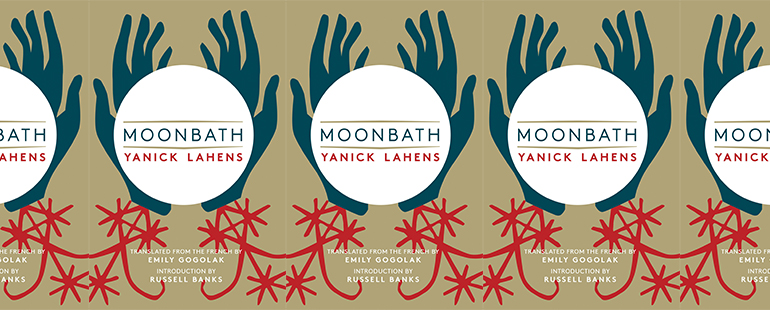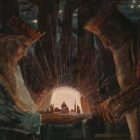Turmoil, Vodou, and Female Strength in Moonbath

Written largely in a collective female voice, Yanick Lahens’s Moonbath, translated from the French by Emily Gogolak, follows the winding tale of four generations in one Haitian family, interspersed with brief observations and memories recounted by the ghost of the youngest—the murdered Cétoute Olmène Thérèse. The two narrative threads unfold a story of inter-class relations, politics, violence, and magic in and around the time of François Duvalier’s brutal reign of the country. From within the extended Lafleur family’s lives, Lahens writes a gripping account of the Duvalier regime, his death squad known as the Macoute, the subsequent brief and tumultuous government of Jean-Baptiste Aristide, and the pervasive acceptance of male domination. Haunted by the stark consequences of patriarchy and political violence, Moonbath, winner of the 2014 Prix Femina and 2015 French Voices Award, is an invigorating and necessary investigation of tradition, politics, loss, and history.
Examples of gender inequality abound in Moonbath, such as viewing women as male possessions and a consistent reappearance of rape. The main narrative of the novel begins with the courtship between Olmène, a sixteen-year-old girl selling vegetables at the market, and Tertulien Mésidor, a powerfully rich man whose family had plunged Olmène’s into poverty years before. Olmène’s mother recalls Tertulien’s father when he approaches their stand in the market—a man “who unceremoniously and without restraint, at the mercy of his will, had taken so many women that he’d forgotten their names as soon as he’d had them.” We quickly learn that Tertulien follows closely in his father’s footsteps: though married, he makes agreements with many women to support them financially in return for a sexual relationship. After buying up all of Olmène’s produce, Tertulien decides that he will have her, a prospect for which Olmène, thinking of the solid house and stability that will come from agreeing to be his mistress, also hopes. But, “once he’d finally settled her in the house, Tertulien took Olmène like she was his property,” marking a quick change in the tone of their relationship. Olmène, however, does not display the submissiveness he expects, instead “leaving him, after every visit, with the dark feeling that his virility had been put into question.” As time moves on, “not standing it any longer, one afternoon, he took her by force.” After this violent rape, Olmène leaves her community in Anse Bleue and her son, Dieudonné, behind. Though we never hear what happens to Olmène after she leaves, her ability to walk away in silence, to exist on her own terms while she had previously seen Tertulien as an opportunity for her to raise her status economically, shows just a sliver of the female strength in the family.
Two generations later, rape reappears in the life of Olmène’s granddaughter, Cétoute Olmène Thérèse, whose ghost narrates the second thread of the novel. As the main story develops, Cétoute periodically reappears to deliver more details of her death, and of the romance with a man named Jimmy. We hear the unfortunate victim-blaming of her friends as she recounts a memory of Jimmy forcing himself on her: “Cocotte and Yvelyne waited for me for a half an hour, not far from Blue Moon. Yvelyne was right to remind me that I looked into men’s eyes too much. And that made peculiar thoughts hatch inside of them. Cocotte, she told me later that it was because of the color of my sandals. Red. That it wasn’t a color you wore to work nor in the middle of the day.” Later revealing that Jimmy, who both raped and murdered Cétoute, is the grandson of Tertulien, the reader at first feels frustrated: could Lahens really write that the granddaughter of Olmène, who so powerfully escaped from the control of Tertulien, ends up raped and murdered by his own grandson? But while Olmène’s strength came in choosing to be absent, Cétoute inherits this decision and more. Silenced against her will, her ghost returns to speak and fill the silence, refusing to succumb to the acceptance of rape and gendered violence. Where the main narrative of her family cannot encompass this resistance, Cétoute’s ghost appears to write it into the book.
Alongside these issues of rape and gender inequality, Lahens deftly portrays the brutal reign of the Duvaliers, the massacres of their death squad, and the illusion of democracy that came in their wake through subtle nods to historical events coupled with graphic scenes of violence and uprising. The policies of François Duvalier and his son, Jean-Claude, also known and Papa Doc and Baby Doc, from 1957 to 1986, haunt the story just like a ghost. Atrocity after atrocity occurs and corruption overtakes the community, all traced back to the unnamed “man in the black hat and thick glasses”—the iconic image of Papa Doc—and the Macoute, his death squad, referred to as the “men in blue.” The massacre of 1963 in Port-au-Prince marks the beginning of the more political portion of the book, as Lahens describes Duvalier’s horrific retaliation on anyone thought to be an enemy after an attempted kidnapping of his son:
Furtive silhouettes skimmed the walls during the night in Port-au-Prince to avoid the headlights of the DKWs. With their helmets, their guns, the blue shadows of the militiamen advanced in the DKWs, combing the insides of the city. They marched in the shadows, forming a hateful mob, chasing after the feverish, trembling shadows that slipped between the trees, hurrying themselves through the dark corridors, trying to blend into the doors, the fences, the windows. . . . Then, the trembling shadows watched out for the steps on the asphalt, blood fixed with fear in their veins, until they were caught in the headlights of a DKW, like a prelude to their second death, the real one. Until a cry, a long sharp blade, slashed the night. . . . In September 1963, the man in the black hat and thick glasses covered the city in a big black veil. Port-au-Prince, blind, falling, on her knees, couldn’t even see her own misfortune and lowered her head amid the cries of stray dogs.
As the situation heightens, one of Olmène’s brothers, Fénelon, “chose to be on the side of those who doled it out. On the side of those with the black glasses, machetes, red scarfs, and revolvers. . . . With no rule of law to block the road to fear, he chose to be the only law, and to generate fear himself.” Rising in power and influence in Duvalier’s troops, he soon cherishes his ability to intimidate. Lahens describes his reputation for cruelty: “Every time Fénelon passed, someone became poorer, lost something, or suddenly felt smaller.” Though she refrains from detailing most of the realities of what his position would have entailed, the blood on his hands is distilled in the killing of a stranger who had passed by the family home and silently ate with them, asking only “that we simply be there for him. To look at him eat and then drink, and then eat again. To remind him that he still belonged to the race of chrétiens-vivants,” or human beings. Two days later, Fénelon returns to the home to proudly “announce that a stranger, a kamoken”—an opponent of the Duvaliers—“had been killed, and that his decapitated head had been sent in a jute sack to Port-au-Prince, to the man in a black hat and thick glasses.” Fénelon’s boastful attitude about his accomplishment contrasts with the family’s shock and grief, which they quickly hide, even from their own brother.
Lahens’s political touch seems almost paradoxical. She often buries references to specific events, people, and experiences behind beautifully crafted yet ambiguous terms, while at the same time, the few prolonged scenes in which she describes the violence in detail call much-needed attention to moments in history that have largely been repressed by politicians or societal trauma. Writing about the 1963 massacre on its fiftieth anniversary in 2013, acclaimed Haitian-American novelist Edwidge Danticat acknowledges the “hazardous task” of remembering this history, noting the far reach of its trauma: an estimated 30,000 to 60,000 were killed during the Duvalier reign. In the face of erasure and attempts from leadership to rewrite the history, the brunt of this task falls on civilians, for whom the pain of memory can be insurmountable. Lahens’s work here is doubly impactful—not only do these scenes write some of the most violent events of the Duvalier regime into the record from the perspective of the people, but her restraint and subtlety also acknowledges and respects the difficulty associated with reliving these moments for so many Haitians.
Just as all of Lahens’s social and political critiques come from within the perspectives and lives of the Lafleur descendants, Haitian vodou is embedded throughout the novel, celebrating its customs and beliefs while also peripherally reminding readers of Duvalier’s exploitation of the tradition to build his cult of personality. The divinities appear almost as characters and family members in Moonbath, mirroring the family’s saying that “the Invisibles, or lwas, are greater than life, but not different from life.” The Lafleur family members frequently refer to various divinities through their daily activities and occasionally gather for large celebrations in which they invite the spirits to take possession of their bodies. Aunt Cilianise, whose husband had died and left her “no longer [wanting] a man of flesh and blood,” even holds a marriage ceremony for her and Ogou, the divinity of war and fire, after whom she dotes by keeping an image of his Catholic double, Saint James the Great, close by. After a long period of waiting for Ogou to appear at her wedding ceremony, Ogou appears by possessing Dieudonné, and the marriage is carried out with him serving as the proxy for Ogou, his movements controlled by an unseen force. Brief moments of joy and closeness for the Lafleur family and their community, the wedding and these celebrations “reconciled Anse Bleue with its old dreams. Those of always. The dreams where the promises of fresh water from the streams poured into rivers which, with all their power, threw themselves into the sea as far as the afterlife.” And while the ubiquitous presence of the Haitian divinities does inherently nod to Duvalier’s claim of being a vodou priest and his regime’s exploitation of the Haitian regard for vodou to elevate himself in the popular eye, Lahens skillfully reclaims the tradition by writing it solely in the context of the Lafleurs.
“Silence is the surest friend. The only one who won’t betray you,” Olmène’s mother warns her against sharing all the details of her life with men as her relationship with Tertulien begins. In this moment, Olmène relishes the security of her space at home with her mother, of traversing “with her, these quiet lands that man never penetrated, except with the ignorance of a conquerer. Where, however conquering he may be, he doesn’t know how to tread.” By leaving Anse Bleue without a word, Olmène refuses to let Tertulien conquer her, and though she leaves her son to be raised by her family, she passes this resistance down. It reemerges in Cétoute, her granddaughter. Where Olmène found power in silence, Cétoute finds it in speaking. Moonbath follows this same vein—by remaining subtle at times and uninhibited at others, Lahens pens an essential family saga in the midst of Haiti’s politically turbulent mid-1900s, one that casts an eye to undiscussed brutality while simultaneously upholding a joyous celebration of culture, family, and female strength.
This piece was originally published on April 9, 2020.


